Mental deficiency
The Mental Deficiency Act, 1913, created three categories of mental handicap ('imbeciles', 'idiots' and the 'feeble-minded' - later abolished by the Mental Health Act, 1959) and gave local County Councils the power to compulsorily detain such certified patients, thus segregating them from the community.
The outbreak of WW1 in 1914 delayed any further action being taken but, in 1919, the Middlesex County Council began to examine various options. In 1920 its Mental Deficiency Committee decided to establish a colony for such patients.
In 1924 the Council purchased the 420-acre Porters Park estate (so named because its first owner in 1340 was Roger Le Porter). (It was said that the vendor, Mr C. Raphael, a wealthy entrepreneur, sold the land to the Council for use as a mental hospital to annoy the great and the good of Shenley after he had been refused membership of the local golf course).
The estate was to become the site of both the Middlesex Colony for Mental Defectives and Shenley Hospital. Part of the land had been used as the London Colney aerodrome during WW1 - it was once the base of Albert Ball (1896-1917) and Edward Mannock (1887-1918), star aviators of the Royal Flying Corps. Three of the aerodrome's aircraft hangars remained on the site and these became incorporated into the new Colony.
The Hangars Certified Institution opened in October 1928 and the first patients, eight high-grade male adults, were admitted, supervised by untrained male attendants. They cleared out the hangars, which were converted into wards and became the foundation for the new Colony. After a few months there were 86 male patients from the County of Middlesex who lived and worked on the site. Construction of the new buildings began in 1929 and the patients were also involved in digging and establishing the gardens.
The first of the new buildings opened in February 1931 and, by December, 342 male patients were in residence. The administration centre, placed on a north-south axis, contained offices, clinic rooms and a dispensary. Behind it were the kitchens, storerooms, workshops and laundry. These central buildings were flanked by 2- or 3-storey villas for male patients on the east side and for female patients on the west. The De Salis Recreational Hall (named after Sir Cecil De Salis, Chairman of the Council's Mental Deficiency Committee) could seat 700 people and was equipped with a stage and a cinema projector. A Nurses' Home was built to the west of the administrative building, adjacent to the main entrance in Harper Lane. The Medical Superintendent's residence was an 18th century farmhouse - Wild Farm - in the grounds of the Institution. Residences for the Deputy Medcial Superintendent and other senior officers were also built, as well as a staff village. The site also contained tennis courts and sports grounds.
Building work continued in stages until 1936. The villas were built around three loop roads, which divided the site into male, female and children's sections (an isolated section on the south side was allocated for the latter). The villas containing wards were designed for different grades of mental handicap, and each was arranged around recreational playing fields and gardens. In the children's section the buildings were one-storey; there was a school block - a single row of classrooms connected by a corridor. Planned to accommodate 1700 mentally handicapped patients of both sexes, in the event the Colony was never fully completed.
The Institution was renamed the Middlesex Colony when it was officially opened in May 1936 by the then Minister of Health, Sir Kingsley Wood.
Opening during the 1930s Depression, the Colony had no shortage of nurses, despite the isolation of the site, the low status of nurses in mentally handicapped institutions and the strict discipline imposed by the Medical Superintendent on both staff and patients. Staff had also been recruited from the Continent, especially Belgium, where such colonies had been established much earlier than in England. Nurses acted as custodians and each patient moving from one part of the Colony would be accompanied by a member of staff. If a patient absconded, this was regarded as a serious failure on the part of the staff member. Anyone losing a key would be instantly dismissed.
The Colony was expected to be mostly self-sufficient, with patients capable of employment providing the labour. Rural life was deemed therapeutic and farming was the major occupation of the male patients. Cattle, pigs and chickens were reared, and fruit and vegetables grown. Surplus milk was sold to the neighbouring Shenley Hospital. Men also worked in the gardens, in the boiler house and in various industrial occupations in the workshops - tailoring, shoe-making, brush-making, carpentry and upholstery. Women were employed in the laundry, kitchens, wards and workshops. Children who were capable of them, were given various simple occupations.
By 1939, at the outbreak of WW2, the Colony had 1194 patients.
In 1948 the Colony became part of the NHS under the control of the Verulam Group Hospital Management Committee, along with Cell Barnes Hospital in St Albans.
In 1950 the Middlesex Colony was renamed Harperbury Hospital.
By the 1950s the Hospital had 1464 beds, with 30 more in an annexe at Bennetts End Hospital in southeast Hemel Hempstead, Hertfordshire. Four additional villas and a new male Nurses' Home were built. A Department of Clinical Psychology was established in order to provide a more precise assessment of mental handicap. The school was enlarged, with the new buildings enclosing the play area to the south. A large wooden building was built to house a swimming pool.
In 1960 a Cerebral Palsy Unit was established, founded by the Nuffield Provincial Hospital Trust. The Unit provided physiotherapy services to Leavesden Hospital and Cell Barnes Hospital, as well as to patients in Bedfordshire. It also provided special treatment for deaf-blind chidlren and for those with multiple physical handicaps. During the early 1960s Harperbury Hospital became a popular place for various government Secretaries of State to visit. Enoch Powell, who visited in 1961, was the first Minister to question the future role of large mental hospitals.
By 1964 overcrowding in the wards had become a severe problem. The accommodation intended for 1354 patients contained some 1587, and it was said that a cyclist could easily ride over the rows of closely packed beds. It was reported on one occasion that a nurse had to crawl across the beds to reach a patient at the far end who was having an epileptic fit.
In 1965 the Kennedy-Galton Centre was officially opened by the Minister of Health. Named after the President of the United States, John F. Kennedy (1917-1963), and the eugenist Sir Francis Galton (1822-1911), the Centre had been established for the study of clinical genetics and to provide a prenatal diagnosis of chromosomal abnormalies in the fetus (the Centre moved to Northwick Park Hospital in 1987).
An Activity Centre was officially opened by Baroness Serota (1919-2002) in 1969. Intended to provide a stimulating environment for the patients, the Centre was expanded in 1973 and a functional playground added.
During the 1970s the Hospital became less institutional. Residents could choose their own bedtimes and were encouraged to take an interest in their personal appearance, and to go shopping in St Albans, four miles away. The sexes were allowed to integrate under the new liberal regime. A pioneering project began, teaching severely handicapped deaf patients the Makaton sign language. Holidays and outings were arranged for the patients, and a holiday home - Verulam House - opened at Broadstairs. To help social integration with the community, sports events - football, cricket, tennis, basketball and netball - were organised against teams from the local police cadets, schools, youth clubs and other hospitals. An Annual Sports Day was held. Voluntary groups arranged cinema shows, discos and other entertainments. Art and Music Therapy classes were introduced. To ease overcrowding the open verandahs were filled in to increase ward space and the long wards divided into smaller bays. The wards were redecorated and the internal brick walls wallpapered.
The farm closed in 1973 as it had become uneconomic (the Ministry of Health had originally recommended the run-down of hospital farms in 1955) and the former bakery became a Handicraft Centre.
In 1974, following reorganisation of the NHS, the Hospital came under the control of the North West District Health Authority. A pre-discharge programme was instituted to help patients resettle in the community via a special training centre, where they learned how to handle money, shop, cook and clean. As more facilities became available in the community, enabled patients moved out of the Hospital. Those remaining had a greater degree of dependence and were more difficult to place. The numbers suitable for training in workshops also fell.
In 1986, following another NHS reorganisation, the Hospital was linked with Leavesden Hospital and Cell Barnes Hospital under the control of a management unit of the North West Hertfordshire District Health Authority. In 1991 the three Hospitals were managed by the Horizon NHS Trust.
In 1994 a new Assessment and Treatment Centre replaced the Admission Assessment Unit which had opened in 1982. Phased closure of the three Hospitals continued, and purpose-built bungalows to house specialist residential units for the remaining patients were built on the Harperbury Hospital site. When Leavesden Hospital closed in 1995 its remaining patients were transferred to Harperbury, and similarly when Cell Barnes Hospital closed in 1998.
Harperbury Hospital finally closed in 2001, the last of the large institutions in the area.
Present status (September 2008)
The central part of the site is still functioning. The administration block, hall, storerooms, laundry, workshops and other buildings are occupied by the Hertfordshire Partnership NHS Foundation Trust.
New bungalows for about 60 to 90 residents with learning disabilities have been built on two sites at Bowlers Green and Harper Lane at the northern part of the site. A new school for children with learning difficulties has been built adjacent to the Hospital entrance in Harper Lane.
In May 2009 two new mental health medium secure units - Oak & Beech Unit - were opened by the Hertfordshire Partnership NHS Foundation Trust, despite parental fears that the development would endanger the neighbouring autistic patients. The 2-storey building with 30 air-conditioned en-suite bedrooms had cost £12m.
The redundant Hospital buildings - the male villas, children's villas and school - are derelict. They are due to be demolished and replaced by new housing.
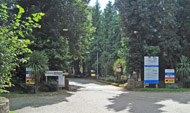
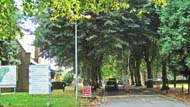
The main entrance drive. The signage refers to 'Harperbury'.

A site map of Harperbury.
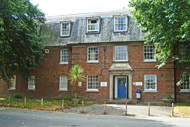
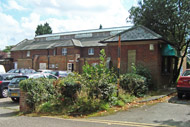
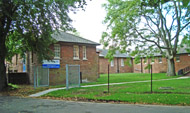
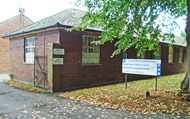
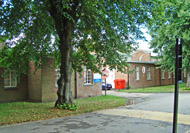

Most of the central buildings are still in use. The site is now largely used for training purposes, such as IT, inductions and postgraduate medical education. Other services include wheelchair assessment and continence services.
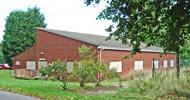
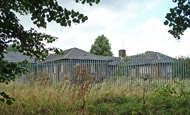
Several buildings are boarded-up, awaiting demolition.
Baranyay E 1981 Fifty Years of Harperbury Hospital 1928-1978. London, National Society for Mentally Handicapped Children and Adults.
Brown K 2001 Harperbury Hospital, from Colony to Closure, 1928-2001. Radlett, Horizon NHS Trust.
http://pb.rcpsych.org
www.bbc.co.uk
www.countryasylums.com
www.derelictplaces.co.uk
www.elizabethpride.com
www.geograph.co.uk
www.hertfordshire-genealogy.co.uk
www.learningdisabilityhistory.com
www.redbridge.gov.uk
www.simoncornwall.com
www.stalbansreview.co.uk
www.studymore.org.uk
Return to home page